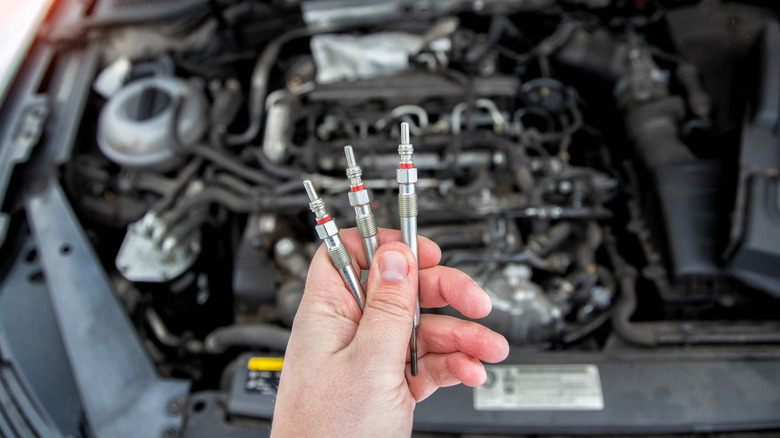Diesel engines have long faced a shared challenge: starting reliably when temperatures drop. Over the decades, automakers have introduced mechanisms to ease cold starts and improve combustion efficiency. Among the most common solutions are glow plugs and intake heaters, two technologies designed to heat air or the combustion chamber to help diesel fuel ignite properly. While both serve the same broad purpose—improving cold-start performance and reducing emissions—their operating principles, design, and maintenance profiles differ in meaningful ways. This article delves into how glow plugs and intake heaters work, their materials and construction, replacement considerations, installation nuances, and practical implications for diesel owners. It is a comprehensive guide intended to clarify how these systems function, when they matter most, and how to approach maintenance and replacement for best performance.
Understanding the Cold-Start Challenge in Diesel Engines
Diesel engines rely on compression ignition. When the piston compresses air within the cylinder, the air’s temperature rises dramatically, and the injected diesel fuel ignites from that heat. This method is efficient and robust under many operating conditions, but it becomes problematic when the engine, battery, or ambient air is cold. In frigid conditions, the air temperature inside the cylinder may not reach the threshold necessary for reliable spontaneous combustion of the diesel fuel. Inadequate heat can lead to prolonged cranking, rough starts, excessive exhaust smoke, higher fuel consumption, and potential engine wear from improper combustion.
To mitigate these issues, diesel systems employ two complementary technologies: glow plugs, which heat the combustion chamber directly, and intake heaters, which warm the incoming air before it enters the cylinders. Both strategies aim to elevate the temperature at the onset of combustion, reducing ignition delays and stabilizing the flame front as the engine starts and transitions to normal running. The strategies share a common goal—ensuring that diesel fuel burns more completely and cleanly as the engine moves from cold idle to operational temperatures—but they execute that goal through different physics and mechanical designs. In the sections that follow, we explore each technology in depth, including how they work, their materials, their advantages and limitations, and practical guidance for owners.
Glow Plugs: Function, Design, and Operation
Glow plugs are specialized heating elements installed in diesel engine combustion chambers. Unlike gasoline engines, which use spark plugs to initiate combustion with an electrical spark, diesel engines rely on high compression and heat to ignite the fuel-air mixture. Glow plugs augment this process by delivering heat directly to the combustion chamber, thereby raising the chamber temperature to a level more conducive to reliable fuel ignition, especially during cold starts.
Key aspects of glow plugs include their location, mechanism, and post-ignition role. Glow plugs are mounted within the combustion chambers themselves. When the vehicle’s ignition is turned on, the glow plugs begin to heat. The heated tips raise the temperature inside the chamber, improving the odds that the incoming diesel fuel will ignite promptly when injected. This is particularly critical in low-temperature environments, where the heat from compression alone may be insufficient to guarantee fast, clean combustion. By the time the engine starts running, glow plugs may continue to provide heat for a brief period, helping to sustain performance as the engine moves into a stable operating state.
Historically, glow plugs were first introduced in automotive applications by Bosch in 1922, marking a significant milestone in diesel technology. Since then, the design has evolved into two primary material categories: ceramic glow plugs and metal glow plugs. Ceramic glow plugs are made from high-temperature ceramic materials and tend to heat up more quickly and efficiently due to their properties. They can provide faster warm-up times and more consistent heat delivery, which translates to more reliable cold starts in some diesel engines. However, ceramic plugs are typically more expensive and can be more fragile, making careful installation and replacement considerations essential for owners who undertake maintenance themselves.
Metal glow plugs, often constructed from platinum, nickel-chromium alloys, or similar high-conductivity materials, offer durability and robustness. They may heat more gradually than ceramic plugs but can provide long service life when used in appropriate engine designs. In many cases, a vehicle’s design will specify which type of glow plug is appropriate, and manufacturers may recommend using the exact same material type for replacement to maintain performance characteristics. This distinction between ceramic and metal plugs is not merely a matter of cost; it can influence heat-up times, endurance in thermal cycling, and how easily a technician can service the component.
Replacement considerations for glow plugs are an essential part of maintenance planning. Over time, glow plugs can wear out or fail, leading to longer cranking times, difficulty starting, or misfires during startup. The replacement process can be technically challenging. Ceramic glow plugs, due to their construction and delicate nature, often require careful handling and sometimes more complex removal and installation procedures. For drivers who are not experienced with diesel maintenance, professional service is a prudent option to avoid accidental damage to the engine or the glow plug seats. In many regions, industry guidance suggests that glow plugs enjoy a long service life, with estimates commonly cited around up to 100,000 miles under typical operating conditions, though actual lifespans vary based on climate, driving habits, duty cycle, and engine design.
The practical takeaway is that glow plugs play a pivotal role in cold-start performance for many diesel engines. Their heat delivery in the combustion chamber is a targeted, chamber-specific solution that complements the engine’s compression ignition system. When properly matched to the engine design and maintained within the vehicle’s service intervals, glow plugs contribute to quicker starts, reduced exhaust smoke, and smoother engine operation as the engine transitions from cold to warm conditions.
Diesel Intake Heaters: Mechanism and Placement
Intake heaters provide a different approach to mitigating cold-start challenges. Rather than heating the combustion chamber directly, intake heaters warm the incoming air before it enters the cylinders. The rationale is straightforward: warmer intake air reduces the thermal gap between the air and fuel when the diesel is injected, helping to promote more stable and complete combustion. By preheating the air, intake heaters contribute to improved ignition reliability, reduced fuel consumption, and lower emissions, particularly in cold-start scenarios where compression heating alone is insufficient.
The heating elements used in intake heaters are typically wire- or ribbon-style elements made from heat-tolerant metal alloys. Common materials include chromium, copper, and nickel, which are selected for their durability, high-temperature performance, and resistance to thermal cycling. These heating elements are integrated into parts of the intake system, such as the intake manifold, the air cleaner assembly, or in between components in the air pathway. When the engine’s electrical system supplies power, the heater elements draw current from the battery to raise the temperature of the incoming air as it travels toward the cylinders.
Placement is a critical design consideration for intake heaters. They must be located in a position where they can efficiently impart heat to the air without impeding airflow or introducing susceptibility to contamination. Typical configurations place the heating elements within the intake manifold or near the air cleaner assembly, ensuring that heated air is delivered to the combustion chamber. Because they rely on electrical power, it’s important to confirm that a vehicle’s charging system is functioning correctly before installing or operating an aftermarket intake heater. A well-functioning alternator and battery are essential to ensure consistent heat delivery, particularly during extended cold-start periods where the heater may operate for longer durations.
Intake heaters offer several practical advantages. They can reduce the amount of unburned fuel and the white smoke commonly associated with cold diesel starts. By preheating the intake air, combustion can be more complete and consistent, which not only supports smoother starts but can also contribute to lower emissions during the critical startup window. For many diesel owners, a properly functioning intake heater reduces wear on starting components and reduces engine stress during cold starts, contributing to overall engine longevity.
Installation of intake heaters is often straightforward for someone with moderate mechanical experience. In many cases, replacing or installing a standard intake heater requires removing a handful of bolts and gaskets to access the heating element. The typical DIY procedure involves disconnecting power, removing the old heater, and reassembling with the new unit, ensuring proper gasket seating and leak-free connections. As with any aftermarket retrofit, it’s important to follow the manufacturer’s instructions precisely and to verify that the new unit is compatible with the vehicle’s engine model and year. A commonly cited example in the aftermarket space is a product like the DIH1 intake heater, which is designed for certain Ram trucks, illustrating how intake heaters are tailored to specific platforms. When considering such installations, ensuring compatibility and adhering to torque specifications are key to a successful and durable replacement.
It’s also worth noting that the strategic placement and design of intake heaters can influence their effectiveness across different climates and operating conditions. In extremely cold environments, the intake air may need more robust preheating to achieve optimal combustion temperatures quickly. Conversely, in milder climates, the heating load may be lower, but the heater can still provide benefits in reducing smoke and enhancing cold-start consistency. The dual approach—glow plugs for the combustion chamber and intake heaters for intake air—offers a comprehensive strategy to address cold-start challenges across a broad range of diesel-engine configurations.
Comparative Differences: Glow Plugs Versus Intake Heaters
Although glow plugs and intake heaters both aim to improve cold-start performance, they operate on distinct principles and produce different practical effects. Understanding these differences helps diesel technicians and vehicle owners diagnose issues, select appropriate maintenance, and optimize starting performance.
Glow plugs are chamber-specific heating elements. Their primary function is to elevate the temperature inside the combustion chamber at or near the moment of ignition, especially when ambient temperatures are low. They contribute directly to combustion readiness by ensuring the air-fuel mixture reaches the ignition temperature reliably. The heat from glow plugs can persist briefly after engine start to support stable combustion as the engine transitions from the crankshaft’s initial torque to sustained running. This post-ignition heat helps maintain performance and reduces the likelihood of late ignition or rough running immediately after starting.
Intake heaters, by contrast, heat the air entering the engine. They act upstream in the intake path, influencing the temperature of the air that mixes with fuel just before combustion. The result is a more favorable combustion environment early in the engine’s start cycle, which translates into smoother starts, reduced smoke, and potentially better fuel efficiency as the engine warms up. Intake heaters operate continuously when power is supplied, drawing energy from the vehicle’s electrical system, whereas glow plugs are activated as part of the ignition sequence and may be used for a set period during cold starts.
In terms of materials and construction, glow plugs typically come in ceramic or metal varieties. Ceramic plugs heat rapidly and are generally more efficient, but their cost and fragility can pose practical challenges. Metal glow plugs—often built from durable alloys like platinum or nickel-chromium—offer robustness but may heat more slowly. The choice between ceramic and metal is influenced by engine design, operating environment, maintenance practices, and the vehicle manufacturer’s recommendations. Replacement considerations are equally important: ceramic plugs sometimes require careful extraction and precise handling to avoid damaging the seat or the plug itself, which can complicate DIY replacement. As a result, professional replacement is a common route for ceramic plugs, particularly for engines where plug access is constrained or where the risk of heat-induced damage is higher.
Intake heaters rely on robust electrical heating elements embedded in the intake path. Their durability hinges on the quality of the heating element materials and the design’s ability to withstand the heat and vibration of diesel operation. Proper installation and secure mounting are essential to prevent heat-related wear, short circuits, or intake leaks. Because intake heaters draw electrical power, their effectiveness is tied to the health of the vehicle’s charging system and battery health. If the alternator or battery is degraded, the heater’s performance may be compromised, especially during extended cold starts or in vehicles that are routinely exposed to very low temperatures.
From a performance perspective, glow plugs tend to have a more direct impact on combustion quality within the cylinder, particularly for engines with high compression ratios or advanced fuel control strategies. They help achieve a reliable ignition temperature for the injected fuel. Intake heaters complement this by ensuring that the incoming air reaches a favorable temperature for efficient combustion. In practice, vehicle operators may notice quicker initial warmth and smoother idle when both systems are functioning well, particularly in regions with cold winters where starting behavior is most tested.
Maintenance, Replacement, and Longevity: Practical Guidance
Maintenance considerations for glow plugs and intake heaters focus on reliability, ease of service, and the potential impact on engine longevity. For glow plugs, key questions include when to replace, how to diagnose failure, and what risks are involved in removal and replacement. Glow plugs are designed to last a long time, with estimates commonly cited up to 100,000 miles under typical conditions. However, environmental factors such as repeated deep freezes, short trip dynamics, and heavy engine loads can shorten their service life. Symptoms of glow plug failure include extended cranking times during cold starts, reduced starting torque, rough running immediately after startup, and elevated exhaust emissions consistent with incomplete combustion.
Diagnosis of glow plug problems can begin with a visual inspection of the plug terminals and harness, followed by voltage testing and resistance checks using proper diagnostic tools. If a plug fails, it can cause misfires or cylinder-specific performance issues, often indicated by a diagnostic trouble code or a start-up abnormality that persists after the engine has warmed. Replacement should be performed with the correct specifications for the engine model and year. When replacing glow plugs, it is important to adhere to torque specifications and to avoid mixing plug types. Ceramic plugs, for example, should not be replaced with metal ones and vice versa, as their heat characteristics and thermal profiles differ. The service procedure often requires careful removal of the old plug from a confined space within the combustion chamber and careful threading of the new plug to avoid damage to the threads or the seat. Given the precision required, many owners opt to have a professional perform glow plug replacement, especially in engines with hard-to-reach plugs or complex intake systems.
Intake heaters similarly require maintenance attention, particularly because their performance is sensitive to electrical supply and the integrity of the heating element. If the intake heater fails or delivers insufficient heat, starts may become delayed, with increased smoke or rough operation during cold starts. Diagnosing an intake heater typically involves electrical testing of the heating element, wiring integrity, and connectors. Replacement is usually straightforward for experienced technicians, as it involves disconnecting the power supply, removing mounting hardware or gaskets, and installing the new heater with proper seating to prevent air leaks. As with glow plugs, verifying compatibility with the engine model and year is critical. The correct heater for a given engine ensures optimal heat output, mechanical fit, and electrical compatibility.
Both systems benefit from routine checks as part of a vehicle’s winter readiness plan. A robust charging system ensures the intake heater can draw the necessary current without placing excessive strain on the battery. Regular maintenance of air intake components, such as the air filter and intake manifold connections, helps to prevent restrictive airflow or heat loss that could undermine heater performance. In addition, ensuring proper engine coolant temperature management supports the effectiveness of glow plugs, since the engine’s temperature operating window interacts with the startup cycle. When these components operate as intended, diesel starting becomes more predictable, emissions are typically lower during startup, and engine wear from repeated hard starts is minimized.
Practical Installation and DIY Considerations
For many diesel owners, knowing when to replace glow plugs and how to install an intake heater is a practical concern. DIY enthusiasts with moderate mechanical experience can tackle certain tasks, but some steps require careful handling and the right tools. Glow plug replacement is a common but delicate job. Because these plugs reside within the combustion chamber, the process must minimize risk of cross-threading, breaking a plug, or damaging the glow plug seats. The complexity is highly engine-specific; some engines provide relatively straightforward access, while others place glow plugs in tight, hard-to-reach locations that demand specialized tools and careful technique. The decision to perform this repair yourself depends on the mechanic’s experience, the engine design, and the risk tolerance for potential engine damage or misalignment.
A recurring theme in glow plug maintenance is the importance of using the appropriate type for replacement. If a vehicle uses ceramic glow plugs, replacing them with metal variants is generally ill-advised due to differences in heat response and thermal cycling performance. Conversely, replacing metal plugs with ceramic variants may not provide the same reliability characteristics and could lead to reliability concerns. It is essential to match the replacement to the engine’s original design specifications to preserve performance and reliability.
Intake heater installation is typically more straightforward for many DIY enthusiasts, particularly when the heater is a direct-fit replacement for a known aftermarket part designed for a specific vehicle. The process commonly involves:
- Power-down and safety precautions, ensuring the battery is disconnected and the engine is cool.
- Removal of a limited number of bolts, clamps, or brackets to access the heater housing and the intake path.
- Replacing gaskets to ensure a proper seal and prevent air leaks that could degrade performance.
- Reassembly with attention to torque specifications and correct routing of electrical connections to avoid interference with moving parts or heat sources.
One practical note for enthusiasts exploring aftermarket options is to verify compatibility with the engine model and year. A widely cited example is a product designed for Ram trucks, illustrating how intake heaters are frequently tailored to specific platforms. When undertaking such replacements, it’s prudent to consult the vehicle’s service manual or manufacturer-provided specifications to confirm the correct part number, installation steps, and any engine software considerations that might affect startup performance or diagnostic monitoring.
In all cases, whether performing glow plug or intake heater maintenance, safety remains paramount. Proper isolation of electrical systems, protection against burns from hot components, and careful handling of pressurized or sealed fuel and air systems are essential to avoiding injury or unintended damage. For many owners, seeking professional service for these components—especially on engines with tight tolerances or in vehicles with limited clearance—offers a balance of safety, reliability, and performance assurance that DIY maintenance alone cannot always guarantee.
Practical Observations, Use Cases, and Real-World Implications
The practical impact of glow plugs and intake heaters varies with climate, driving patterns, and engine design. In cold climates, both technologies can substantially improve starting reliability and reduce the amount of time the engine spends in a high-emission startup phase. With glow plugs, the direct heating in the combustion chamber helps ensure that diesel fuel ignites promptly, reducing cold-start sputter and roughness. With intake heaters, heater elements precondition the air entering the engine, leading to more consistent combustion and potentially smoother operation during the initial moments of startup. In combination, glow plugs and intake heaters provide a comprehensive approach to cold-start performance, particularly valuable in engines designed to maximize efficiency and minimize emissions across a wide range of temperatures.
Owners considering maintenance or replacement should weigh the relative costs and benefits of each technology. Glow plug replacement may be more frequent in climates with frequent deep freezes or shorter driving cycles that prevent the engine from reaching normal operating temperatures quickly. Intake heater performance, while benefiting from a healthy electrical system, can degrade if the heater element or wiring is damaged or if the air pathway becomes obstructed or leaky. Both systems are designed to be durable, but their longevity depends on operating conditions, maintenance quality, and proper installation practices.
From an emissions and efficiency perspective, effective cold-start systems help reduce white smoke and promote cleaner combustion. A well-functioning glow plug or intake heater reduces the likelihood of incomplete combustion, which translates into lower emissions in the critical startup window. Drivers who operate their vehicles in regions with cold seasons should prioritize ensuring both systems are in good working order, especially for older vehicles where aging components may fail and lead to degraded performance.
Compatibility, Innovation, and Future Trends
As automotive technology evolves, so do the strategies for improving cold-start performance. Glow plugs remain a standard in many diesel engines, particularly in applications where chamber heat is a critical factor in achieving reliable ignition and smooth startup. The materials science behind glow plugs continues to advance, with ongoing research into ceramic formulations and metal alloys that improve heat transfer, durability, and resistance to thermal cycling. Intake heaters, too, benefit from advances in heating element materials and more efficient electrical integration, enabling effective preheating with reduced electrical load and improved reliability.
Engineers design these systems around the target engine, fuel system, and emission standards for a given vehicle model. This means that replacement parts, installation procedures, and maintenance intervals are often highly model-specific. For diesel enthusiasts and professional mechanics, staying informed about the exact specifications published by the vehicle manufacturer is essential for ensuring that any replacement component—whether glow plug or intake heater—is correct for the engine and year in question.
In practice, the choice between maintenance emphasis on glow plugs or intake heaters depends on the engine’s design and the user’s climate. Some engines rely more heavily on glow plugs to ensure combustion chamber readiness, while others emphasize intake heating as a primary method of preparing the air for combustion. For modern engines equipped with sophisticated fuel management and electronic control, both systems may be integrated with onboard diagnostics to monitor performance. In this integrated context, owners can benefit from software updates or diagnostics that help identify failing components, optimize heat delivery, and confirm that the startup sequence proceeds as designed.
Conclusion
Diesel engines face a persistent cold-start challenge, and glow plugs and intake heaters address this challenge through distinct yet complementary approaches. Glow plugs heat the combustion chamber to raise the ignition temperature directly, a crucial function in facilitating reliable diesel combustion during cold starts. Intake heaters warm the incoming air, improving the combustion environment before fuel is injected and ignited. Each technology has unique materials, benefits, and maintenance considerations. Ceramic glow plugs offer rapid heat-up and efficiency but can present replacement complexities, while metal glow plugs emphasize durability and ease of service. Intake heaters rely on durable heating elements made from robust metal alloys and must be paired with a reliable electrical system to maintain consistent performance.
Maintenance and replacement require careful attention to engine design, part compatibility, and installation procedures. For many drivers, professional service is advisable when replacing glow plugs—particularly ceramic variants—or when installing aftermarket intake heaters designed for specific vehicle platforms. In all cases, ensuring compatibility with the engine model, year, and electrical system health is essential to sustaining efficient, reliable cold-start performance, reducing emissions, and extending engine life.
A well-maintained cold-start system, whether relying on glow plugs, intake heaters, or a carefully coordinated combination of both, helps diesel engines start smoothly in cold weather and operate efficiently as they move toward normal operating temperatures. With the right parts, proper installation, and attentive maintenance, glow plugs and intake heaters continue to play a pivotal role in diesel reliability, performance, and longevity across a wide range of vehicles and climates.



